Click on images to enlarge

large infestation (Photo: Forest and Kim Starr, USGS)
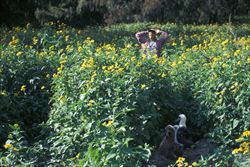
dense infestation in seabird nesting area in Hawaii (Photo: Forest and Kim Starr, USGS)
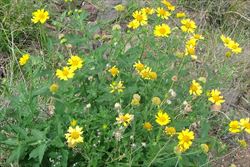
habit (Photo: Sheldon Navie)
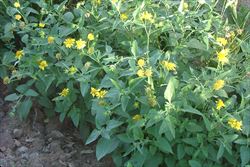
habit (Photo: Sheldon Navie)
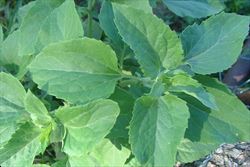
leaves with sharply-toothed margins (Photo: Sheldon Navie)

close-up of leaf and younger stem, showing covering of fine whitish hairs (Photo: Sheldon Navie)
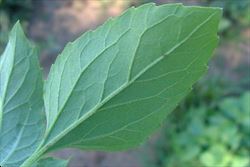
close-up of leaf underside (Photo: Sheldon Navie)
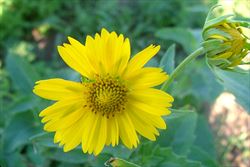
open flower-head with young flower-head enclosed in numerous green bracts (Photo: Sheldon Navie)
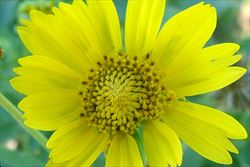
close-up of flower-head showing numerous yellow tubular florets (Photo: Sheldon Navie)
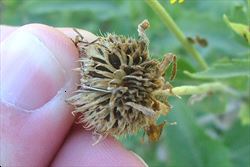
close-up of mature fruit (Photo: Sheldon Navie)
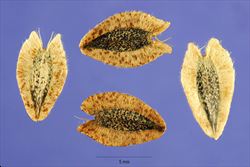
close-up of seeds (Photo: Steve Hurst at USDA PLANTS Database)

seedling (Photo: Sheldon Navie)
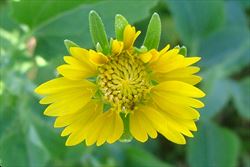
young flower-head with numerous deelply-toothed 'petals' (Photo: Sheldon Navie)
Scientific Name
Verbesina encelioides (Cav.) Benth. & Hook. f. ex A. Gray
Synonyms
Verbesina encelioides (Cav.) Benth. & Hook. f. ex A. Gray subsp. encelioidesXimenesia encelioides Cav.
Family
Asteraceae (Queensland, New South Wales, the ACT, Victoria, Tasmania, Western Australia and the Northern Territory)Compositae (South Australia)
Common Names
American dogweed, butter daisy, cowpen daisy, crown beard, crown-beard, crownbeard, gold weed, golden crown beard, golden crown daisy, golden crown-beard, golden crownbeard, skunk daisy, South African daisy, wild sunflower, yellowtop
Origin
Native to North America (i.e. southern and western USA and northern and central Mexico).
Naturalised Distribution
A very widespread introduced species that is mainly found in the eastern parts of Australia. It is naturalised in southern and central Queensland, New South Wales, north-western and central Victoria, south-eastern South Australia, the coastal districts of western and northern Western Australia and the southern parts of the Northern Territory.
Habitat
A weed of pastures, creek-banks, floodplains, open woodlands, grasslands, roadsides, crops, disturbed sites and waste areas in warmer temperate, sub-tropical, semi-arid and tropical regions.
Habit
A short-lived (i.e. annual) herbaceous plant usually growing 0.3-1.6 m tall.
Distinguishing Features
- a short-lived herbaceous plant usually growing 0.3-1.6 m tall.
- its stems and younger leaves are covered in fine white hairs that give them a greyish-green appearance.
- its triangular or egg-shaped leaves (4-10 cm long and 1-4 cm wide) have sharply-toothed margins.
- its yellow flower-heads (2.5-5 cm across) resemble small sunflowers with about 12-15 yellow 'petals' 1-2 cm long.
- its greyish-brown 'seeds' (5-8 mm long) have two broad pale coloured wings and are topped with two fine bristles (1-2 mm long).
Stems and Leaves
The stems are covered in fine white hairs that give them a greyish-green appearance (i.e. they are finely pubescent).
The leaves are mostly triangular or egg-shaped in outline (i.e. ovate), however the upper most ones are more elongated in shape (i.e. lanceolate). The lower leaves are paired (i.e. oppositely arranged), while the upper leaves are alternately arranged. These leaves (4-10 cm long and 1-4 cm wide) have sharply-toothed (i.e. serrate) or slightly lobed margins and are borne on short stalks (i.e. petioles). The upper and lower leaf surfaces are both covered in fine white hairs, particularly on the lower surface which have a greyish-white appearance.
Flowers and Fruit
The yellow flower-heads (2.5-5 cm across) resemble small sunflowers and are borne singly at the tops of the branches on long stalks (i.e. peduncles) up to 25 cm long. The bases of these flower-heads (i.e. capitula) are surrounded by two rows of elongated green bracts (i.e. involucral bracts). Each flower-head has about 12-15 yellow or bright yellow 'petals' (i.e. ray florets) 1-2 cm long that are deeply toothed at the tip. There are also numerous small yellow flowers (i.e. tubular or disc florets) in the centre of each flower-head. Flowering occurs mainly during spring and summer.
The brown or greyish-brown 'seeds' (i.e. achenes) are flattened, finely hairy (i.e. pubescent) and 5-8 mm long. They have two broad pale coloured wings and are topped with two fine bristles (1-2 mm long).
Reproduction and Dispersal
This species reproduces by seed, which are easily dispersed by wind and water. They may also be spread by vehicles, in soil or in contaminated agricultural produce.
Environmental Impact
Crownbeard (Verbesina encelioides) is regarded as and environmental weed in Queensland, and as a minor or potential environmental weed in Western Australia, New South Wales and Victoria. It was recently listed as a priority environmental weed in at least one Natural Resource Management region.
Legislation
Not declared or considered noxious by any state government authorities.

